
A more recent article on end-of-life palliative care is available.
Am Fam Physician. 2017;95(6):356-361
Patient information: See related handout on care for people with a severe or complicated illness.
Author disclosure: No relevant financial affiliations.
Physicians should be proficient at managing symptoms as patients progress through the dying process. When possible, proactive regimens that prevent symptoms should be used, because it is generally easier to prevent than to treat an acute symptom. As swallowing function diminishes, medications are typically administered sublingually, transdermally, or via rectal suppository. Opiates are the medication of choice for the control of pain and dyspnea, which are common symptoms in the dying process. Delirium and agitation may be caused by reversible etiologies, which should be identified and treated when feasible. When medications are required, haloperidol and risperidone are effective options for delirium. Nausea and vomiting should be treated with medications targeting the etiology. Constipation may be caused by low oral intake or opiate use. Preventive regimens to avoid constipation should include a stimulant laxative with a stool softener. Oropharyngeal secretions may lead to noisy breathing, sometimes referred to as a death rattle, which is common at the end of life. Providing anticipatory guidance helps families and caregivers normalize this symptom. Anticholinergic medications can modestly help reduce these secretions. Effective symptom control in end-of-life care can allow patients to progress through the dying process in a safe, dignified, and comfortable manner.
In its report “Dying in America,” the Institute of Medicine stresses that “all clinicians across disciplines and specialties who care for people with advanced serious illness should be competent in basic palliative care, including communication skills, interprofessional collaboration, and symptom management.”1 As clinicians assist patients and families through the course of disease, eventually, the care will focus on symptom management in the last weeks and days of life. Outside of the hospital, these care plans are directed by primary care physicians and subspecialists who have been managing patients' primary illness, often without the aid of a palliative medicine–trained physician. Therefore, it is imperative that clinicians understand how to help these patients achieve symptom relief. This review focuses on the outpatient management of common symptoms in persons at the end of life, whether in the home, assisted living facility, or nursing home environment.
| Clinical recommendation | Evidence rating | References |
|---|---|---|
| Opiates should be used to treat dyspnea in end-of-life care. | B | 3–5 |
| Haloperidol and risperidone (Risperdal) are effective in treating delirium in end-of-life care. | C | 17 |
| Corticosteroids should be used in the management of bowel obstruction caused by malignancy. Octreotide (Sandostatin) has been shown to have limited benefit. | B | 28, 29 |
| Hyoscyamine (Levsin) or atropine ophthalmic drops can be used to treat excessive oropharyngeal secretions, although evidence supporting their use is limited. | C | 33, 34 |
General Principles
Clinicians should follow certain guiding principles when prescribing medications for symptom management at the end of life. Medications should be used to treat the primary etiology of a symptom. For example, if a patient is anxious because of shortness of breath, treatment should focus on the dyspnea to alleviate the primary symptom and then the resulting anxiety.
Medications should generally start at lower dosages before titrating to the desired effect. The dosing should initially be as needed and then transitioned to a standing dosage or long-acting medication for symptom management. When possible, proactive regimens that prevent symptoms should be used, because it is generally easier to prevent than to treat an acute symptom.
Because disrupted swallowing function and changes in the level of wakefulness can affect patients' ability to swallow pills, medications must be provided in formulations that are safe and feasible for administration. Concentrated sublingual medications, dissolvable tablets, transdermal patches, creams or gels, and rectal suppositories can be given to patients with impaired swallowing and decreased responsiveness. Less common formulations may be obtained at local compounding pharmacies and hospice pharmacies. If sublingual tablets are used, mucous membranes must remain moist through careful oral care to allow for optimal absorption.
Pain
Pain is a common symptom occurring in approximately 50% of persons in the last month of life.2 It is important to recognize a patient's total pain, which includes not only physical symptoms but also the psychological, social, and spiritual components of distress. Although regulations and scrutiny surrounding the use of opiates for acute and chronic pain have increased, opiates remain the medication of choice for treating physical pain in patients at the end of life (Table 1).3–6 A review of pain management at the end of life was recently published in American Family Physician and can provide additional information on this topic.7
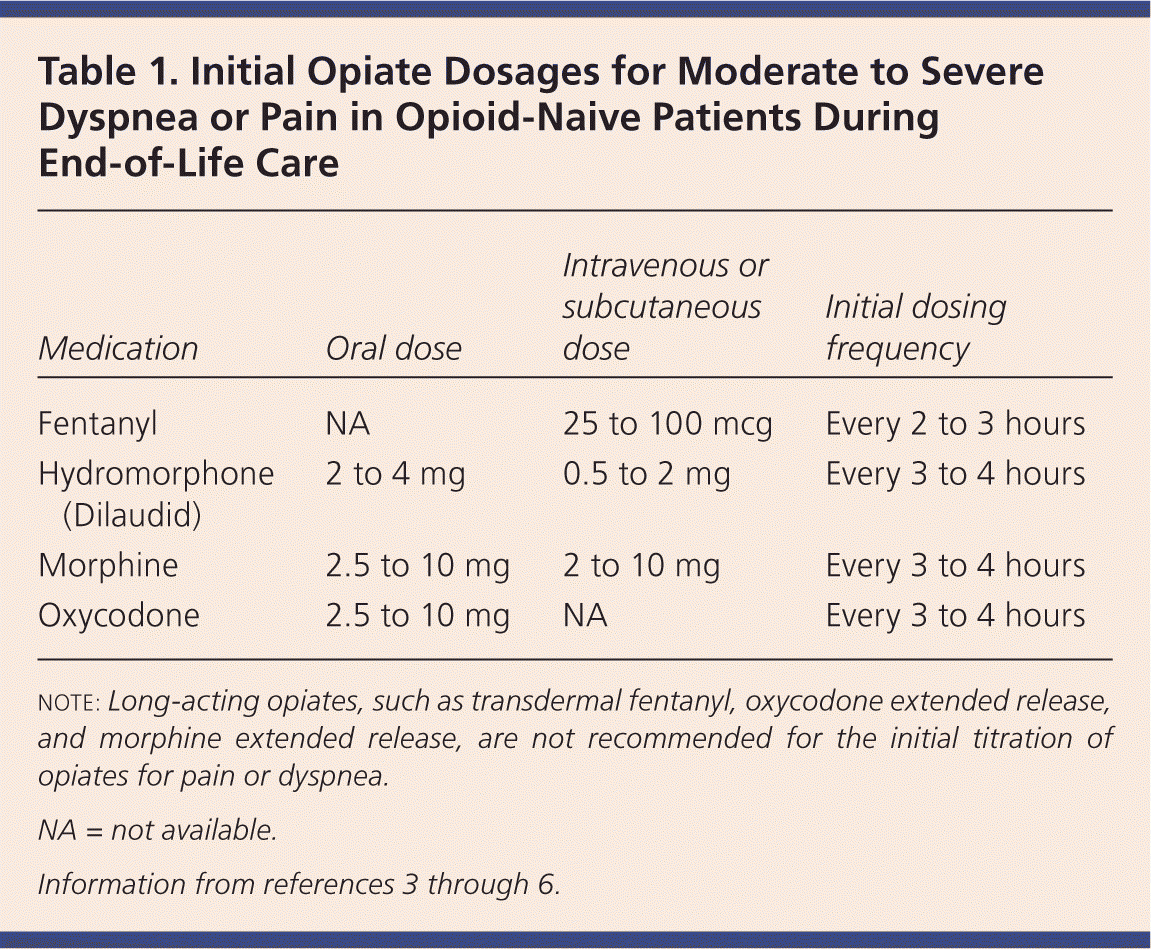
| Medication | Oral dose | Intravenous or subcutaneous dose | Initial dosing frequency |
|---|---|---|---|
| Fentanyl | NA | 25 to 100 mcg | Every 2 to 3 hours |
| Hydromorphone (Dilaudid) | 2 to 4 mg | 0.5 to 2 mg | Every 3 to 4 hours |
| Morphine | 2.5 to 10 mg | 2 to 10 mg | Every 3 to 4 hours |
| Oxycodone | 2.5 to 10 mg | NA | Every 3 to 4 hours |
Dyspnea
Although dyspnea often occurs in patients with end-stage pulmonary and cardiac disease, it is also regularly observed in patients with cancer, cerebrovascular disease, or dementia.8–11 Dyspnea can be caused by a number of different mechanisms, including aspiration pneumonitis or pneumonia, airway hyperreactivity, pulmonary edema, pleural effusions, and deconditioning. Measuring and quantifying dyspnea in patients with decreased responsiveness at the end of life can be challenging because most dyspnea scales require the patient to report symptoms. The Respiratory Distress Observation Scale (http://homecareinformation.net/handouts/hen/Respiratory_Distress_Observation_Scale.pdf) is an eight-variable tool yielding a score of 0 (no dyspnea) to 16 (most dyspnea) based on observers' clinical assessments, and has been studied in the care of patients at the end of life.12 Tachypnea, increased difficulty breathing, restlessness, and grunting are clinical signs of dyspnea, regardless of a patient's measured oxygen saturation.
Opiates are the medication of choice for the management of breathlessness in end-of-life care.3–5 When administered at appropriate doses, opiates do not reduce or compromise respiratory status and do not hasten dying.13,14 Opiates help to reduce the sense of air hunger in patients with dyspnea. The use of opiates for palliative therapy in advanced pulmonary disease is supported by clinical guidelines from the American Thoracic Society.6
Opiates should be selected and administered based on patients' comorbidities, previous opiate exposure, and the ease of administration. Opiates should be started at low doses with short dosing intervals and first provided on an as-needed basis. Common initial dosing regimens for dyspnea are shown in Table 1.3–6 This will allow for rapid titration, which prescribers can use to calculate the total daily dosage needed to control symptoms. This total dosage can be transitioned to long-acting medications plus continued breakthrough doses of short-acting opiates to be used as needed. Morphine and oxycodone are available in concentrated forms and sublingual formulations, which allow for rapid administration regardless of a patient's level of wakefulness or swallowing ability because of the small volumes needed per dose. Data do not appear to support the use of nebulized opiates for dyspnea at the end of life.15
Delirium and Agitation
Patients often experience delirium and agitation in the last days and weeks of life.16 Symptoms that do not cause the patient distress can be managed conservatively without medication. It is essential to assess for reversible or treatable causes of delirium, such as medication adverse effects, uncontrolled pain or discomfort, constipation, or urinary retention.
Antipsychotic medications such as haloperidol and risperidone (Risperdal) are effective in the treatment of delirium and agitation in end-of-life care.17 Dosing for delirium tends to be significantly lower than for psychiatric disorders, such as schizophrenia.18,19 Benzodiazepines should be used with caution for the treatment of agitation and delirium, because they can potentially provoke increased symptoms in older patients.20 However, benzodiazepines can effectively treat anxiousness and agitation in the last hours and days of life because of their potentially sedating effects.
In patients with severe, refractory agitation, palliative sedation may be considered. Palliative sedation is defined as the intentional lowering of awareness toward, and including, unconsciousness for patients with severe and refractory symptoms. It should be considered only when symptoms do not respond to alternative therapies and should always be performed in consultation with a palliative medicine or hospice-trained clinician.21,22 A “Curbside Consultation” article on this topic is available at https://www.aafp.org/afp/2011/0501/p1094.html.
Nausea and Vomiting
Nausea and vomiting are common in end-of-life care. Multiple receptor pathways in the brain and in the gastrointestinal tract mediate nausea and vomiting. Medications that target dopaminergic pathways, such as haldoperidol, risperidone, metoclopramide (Reglan), and prochlorperazine, are often used as first-line therapies for nausea because of their inhibition of receptors in the brain's chemoreceptor trigger zone.23,24 Haloperidol and risperidone can be administered as oral liquid concentrates, and prochlorperazine can be administered via suppository if patients are unable to take pills. Serotonin 5-HT3 receptor antagonists, such as ondansetron (Zofran) and palonosetron (Aloxi), have been studied in chemotherapy- and radiation therapy–induced nausea, and are available as dissolvable tablets. In treating nausea at the end of life, studies have not shown these more costly 5-HT3 medications to be superior to the older dopaminergic agents mentioned previously.25,26
When first-line agents are unable to control nausea, a second agent may be added. Anticholinergic medications such as meclizine (Antivert) or transdermal scopolamine can be added when a vestibular component of nausea is present. Corticosteroids, such as dexamethasone, have been studied for chemotherapy-induced nausea and are another potentially effective second-line agent for nausea control. Synthetic cannabinoid agents (e.g., dronabinol [Marinol]) and medical marijuana (in states where it is approved for medical use) can also be considered as second-line agents for nausea control. It should be noted that these second-line agents can provoke delirium and should be used with caution (Table 2).23–28
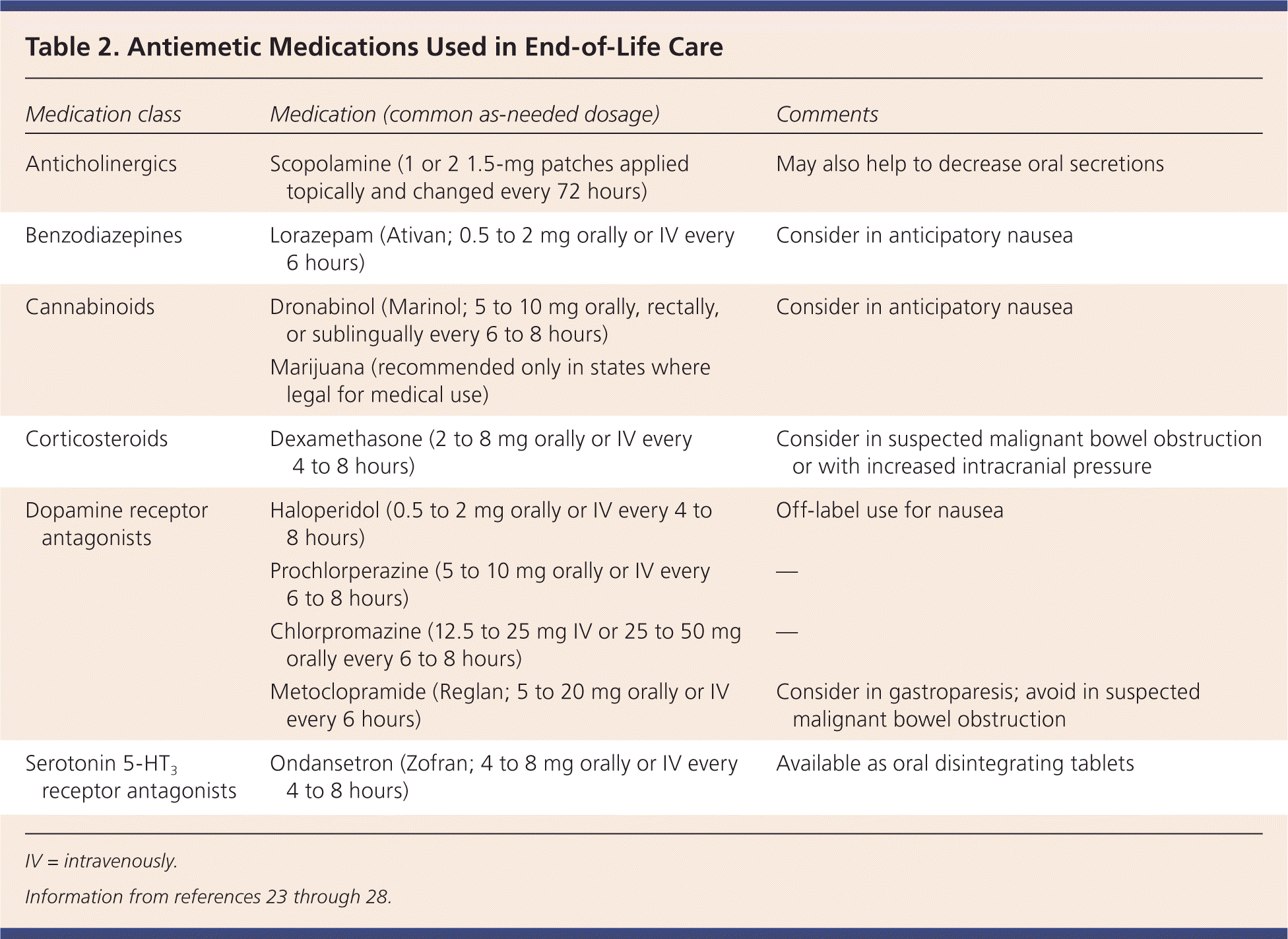
| Medication class | Medication (common as-needed dosage) | Comments |
|---|---|---|
| Anticholinergics | Scopolamine (1 or 2 1.5-mg patches applied topically and changed every 72 hours) | May also help to decrease oral secretions |
| Benzodiazepines | Lorazepam (Ativan; 0.5 to 2 mg orally or IV every 6 hours) | Consider in anticipatory nausea |
| Cannabinoids | Dronabinol (Marinol; 5 to 10 mg orally, rectally, or sublingually every 6 to 8 hours) | Consider in anticipatory nausea |
| Marijuana (recommended only in states where legal for medical use) | ||
| Corticosteroids | Dexamethasone (2 to 8 mg orally or IV every 4 to 8 hours) | Consider in suspected malignant bowel obstruction or with increased intracranial pressure |
| Dopamine receptor antagonists | Haloperidol (0.5 to 2 mg orally or IV every 4 to 8 hours) | Off-label use for nausea |
| Prochlorperazine (5 to 10 mg orally or IV every 6 to 8 hours) | — | |
| Chlorpromazine (12.5 to 25 mg IV or 25 to 50 mg orally every 6 to 8 hours) | — | |
| Metoclopramide (Reglan; 5 to 20 mg orally or IV every 6 hours) | Consider in gastroparesis; avoid in suspected malignant bowel obstruction | |
| Serotonin 5-HT3 receptor antagonists | Ondansetron (Zofran; 4 to 8 mg orally or IV every 4 to 8 hours) | Available as oral disintegrating tablets |
Severe constipation can lead to abdominal discomfort and nausea, which may improve with the treatment of constipation. Proactively managing a medication regimen that prevents constipation is a critical component of effective end-of-life care.
Vomiting can occur because of mechanical bowel obstruction. Malignant bowel obstruction is common with pelvic and gastrointestinal cancers.27 Clinical symptoms of malignant bowel obstruction include nausea, vomiting, abdominal pain, and an inability to tolerate oral intake. When malignant bowel obstruction is suspected in end-of-life care, medical management with an antiemetic (e.g., haloperidol), as well as corticosteroids and analgesics, is recommended.28 Octreotide (Sandostatin) has been used for the management of malignant bowel obstruction, but the data supporting its use are not robust.29 Some patients with malignant bowel obstruction have a prophylactic venting gastrostomy tube placed earlier in the disease process to release pressure upstream of the obstruction and prevent vomiting. Caution should be used in placing new venting gastrostomy tubes in the final days of life because of the high risk of procedural complications and a lack of quality evidence showing prolongation of life.30
Constipation
Effective management of constipation in end-of-life care is critical, because constipation can lead to pain, vomiting, restlessness, and delirium. Low oral intake of food and fluids and adverse effects of opiates are common etiologies. Preventive regimens generally include a stimulant laxative (e.g., senna) with a stool softener (e.g., docusate [Colace], polyethylene glycol [Miralax]). Dosing regimens for these medications are listed in Table 3.31 If constipation occurs despite preventive measures, prompt treatment with stronger laxatives, suppositories, or enemas is indicated. Methylnaltrexone (Relistor) is approved by the U.S. Food and Drug Administration for the treatment of opiate-related constipation that does not respond to traditional preventive and treatment regimens, although its higher cost often limits its use.32
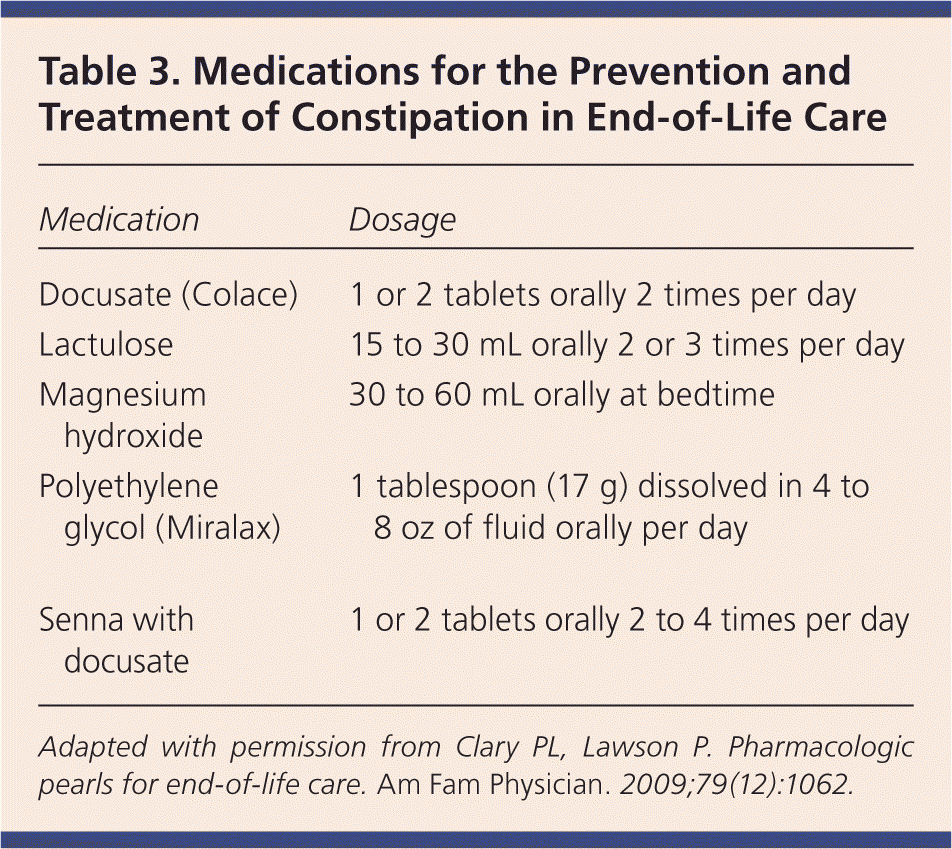
| Medication | Dosage |
|---|---|
| Docusate (Colace) | 1 or 2 tablets orally 2 times per day |
| Lactulose | 15 to 30 mL orally 2 or 3 times per day |
| Magnesium hydroxide | 30 to 60 mL orally at bedtime |
| Polyethylene glycol (Miralax) | 1 tablespoon (17 g) dissolved in 4 to 8 oz of fluid orally per day |
| Senna with docusate | 1 or 2 tablets orally 2 to 4 times per day |
Oropharyngeal Secretions
It is common for patients to lose the ability to manage and clear their oropharyngeal secretions as they progress through the dying process.33 This can result in a noisy breathing pattern, sometimes referred to as a death rattle. Generally, these secretions are not bothersome to the patient; rather, the family and caregivers are usually more troubled by the sound. A key component in reassuring family members and caregivers is good anticipatory guidance to normalize and destigmatize the breathing pattern. Although anticholinergic medications are often used to manage secretions, there is a lack of high-quality data to support their use.34 Commonly used medications for treating excessive oropharyngeal secretions with their usual starting dosages are shown in Table 4.33,34 These medications include hyoscyamine (Levsin), atropine, glycopyrrolate (Robinul), and scopolamine.
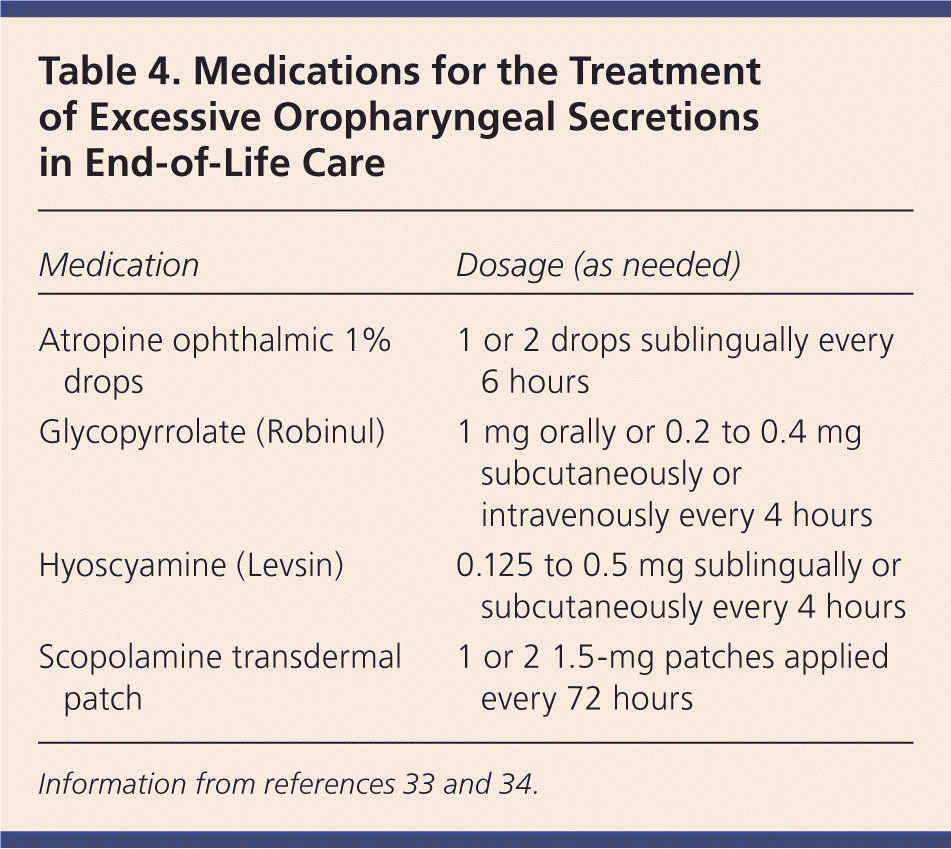
| Medication | Dosage (as needed) |
|---|---|
| Atropine ophthalmic 1% drops | 1 or 2 drops sublingually every 6 hours |
| Glycopyrrolate (Robinul) | 1 mg orally or 0.2 to 0.4 mg subcutaneously or intravenously every 4 hours |
| Hyoscyamine (Levsin) | 0.125 to 0.5 mg sublingually or subcutaneously every 4 hours |
| Scopolamine transdermal patch | 1 or 2 1.5-mg patches applied every 72 hours |
Fever
Treatment of fever at the end of life is based on the patient's life expectancy and goals of care. Fever may be treated with antipyretic medications such as acetaminophen, nonsteroidal anti-inflammatory drugs, or corticosteroids, when appropriate. Acetaminophen suppositories can be safely administered in patients with impaired swallowing function. Conservative measures without medication may be considered if the fever is not causing secondary discomfort or if such measures are consistent with the patient's and family's goals of care.
Final Comment
Effective management of symptoms at the end of life is challenging but often can be achieved with fewer than four or five key medications (Table 5). Clinicians can help support patients and families through this process with the assurance that it will be as safe, dignified, and comfortable as medically possible.
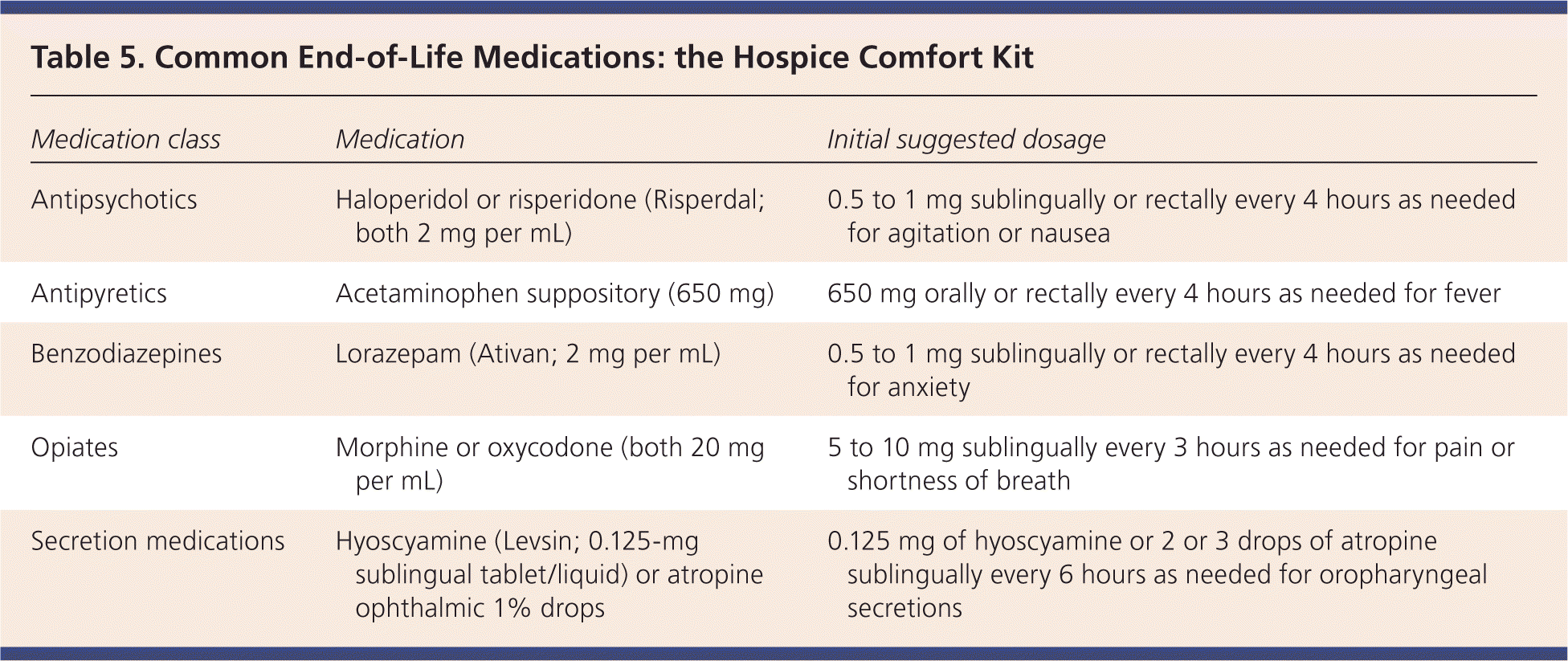
| Medication class | Medication | Initial suggested dosage |
|---|---|---|
| Antipsychotics | Haloperidol or risperidone (Risperdal; both 2 mg per mL) | 0.5 to 1 mg sublingually or rectally every 4 hours as needed for agitation or nausea |
| Antipyretics | Acetaminophen suppository (650 mg) | 650 mg orally or rectally every 4 hours as needed for fever |
| Benzodiazepines | Lorazepam (Ativan; 2 mg per mL) | 0.5 to 1 mg sublingually or rectally every 4 hours as needed for anxiety |
| Opiates | Morphine or oxycodone (both 20 mg per mL) | 5 to 10 mg sublingually every 3 hours as needed for pain or shortness of breath |
| Secretion medications | Hyoscyamine (Levsin; 0.125-mg sublingual tablet/liquid) or atropine ophthalmic 1% drops | 0.125 mg of hyoscyamine or 2 or 3 drops of atropine sublingually every 6 hours as needed for oropharyngeal secretions |
Data Sources: A PubMed search was completed in Clinical Queries using the key terms hospice, palliative care, dyspnea, delirium, nausea, oropharyngeal secretion, death rattle, end-of-life care, fever, opiates, haloperidol, benzodiazepine, and malignant bowel obstruction. The search included meta-analyses, randomized controlled trials, clinical trials, and reviews. Also searched were the Agency for Healthcare Research and Quality evidence reports, Clinical Evidence, the Cochrane database, Database of Abstracts of Reviews of Effects, the Institute for Clinical Systems Improvement, the National Guideline Clearinghouse database, Essential Evidence Plus, and UpToDate. Search dates: January 26, 2016, and November 28, 2016.
